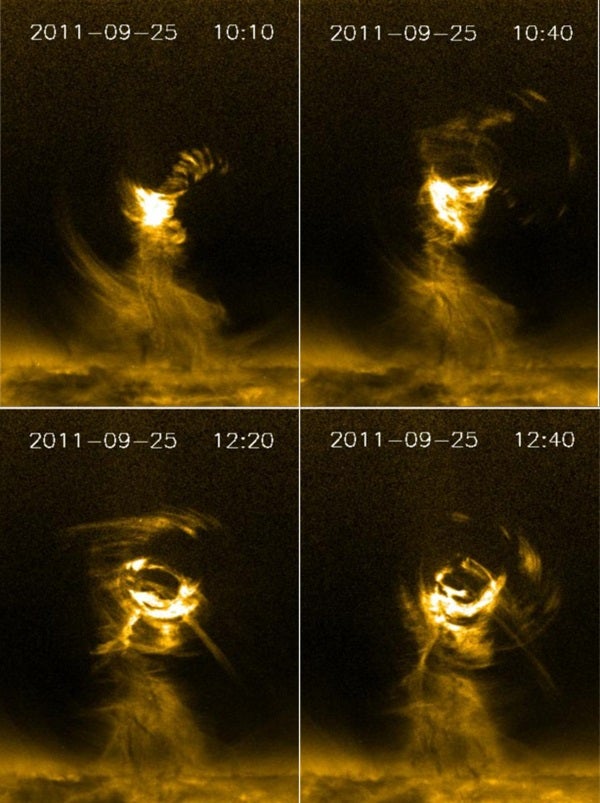Solar tornadoes several times as wide as Earth can be generated in the solar atmosphere, say researchers in the United Kingdom. Scientists discovered such a storm using the Atmospheric Imaging Assembly (AIA) telescope aboard NASA’s Solar Dynamic Observatory (SDO) satellite.
“This is perhaps the first time that such a huge solar tornado [was] filmed by an imager,” said Xing li of Aberystwyth University in Wales. “Previously, much smaller solar tornadoes were found by [the Solar and Heliospheric Observatory] SOHO satellite, but they were not filmed.”
Huw Morgan, co-discover of the solar tornado, added, “This unique and spectacular tornado must play a role in triggering global solar storms.”
On September 25, 2011, the AIA saw superheated gases as hot as 50,000 to 2,000,000 kelvin get sucked from the root of a dense structure called a prominence, spiral up into the high atmosphere, and travel about 124,000 miles (200,000 kilometers) along helical paths for a period of at least three hours. The hot gases in the tornadoes had speeds as high as 186,000 mph (300,000 km/h). Gas speeds of terrestrial tornadoes can reach 93 mph (150 km/h).
The tornadoes often occur at the root of coronal mass ejections (CMEs) — huge eruptions of electrified, magnetic gas ejected from the solar corona. When heading toward Earth, these CMEs can cause significant damage to our planet’s space environment, satellites, and electricity grid.
The solar tornadoes drag winding magnetic field and electric currents into the high atmosphere. It is possible that the magnetic field and currents play a key role in driving CMEs.
“This is perhaps the first time that such a huge solar tornado [was] filmed by an imager,” said Xing li of Aberystwyth University in Wales. “Previously, much smaller solar tornadoes were found by [the Solar and Heliospheric Observatory] SOHO satellite, but they were not filmed.”
Huw Morgan, co-discover of the solar tornado, added, “This unique and spectacular tornado must play a role in triggering global solar storms.”
On September 25, 2011, the AIA saw superheated gases as hot as 50,000 to 2,000,000 kelvin get sucked from the root of a dense structure called a prominence, spiral up into the high atmosphere, and travel about 124,000 miles (200,000 kilometers) along helical paths for a period of at least three hours. The hot gases in the tornadoes had speeds as high as 186,000 mph (300,000 km/h). Gas speeds of terrestrial tornadoes can reach 93 mph (150 km/h).
The tornadoes often occur at the root of coronal mass ejections (CMEs) — huge eruptions of electrified, magnetic gas ejected from the solar corona. When heading toward Earth, these CMEs can cause significant damage to our planet’s space environment, satellites, and electricity grid.
The solar tornadoes drag winding magnetic field and electric currents into the high atmosphere. It is possible that the magnetic field and currents play a key role in driving CMEs.










